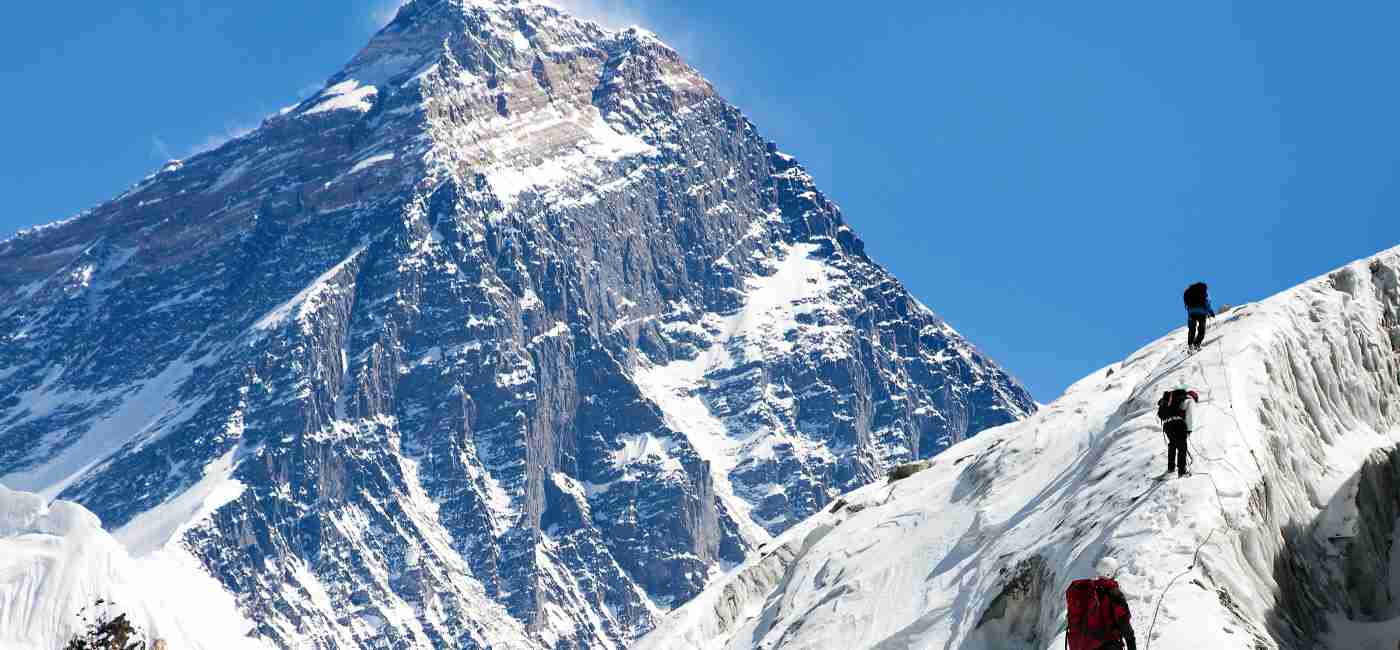On May 16, 2018, Venkatesh Maheshwari also known as Venki, stood on the summit of Mt Everest, the highest peak in the world at 29,000 feet. It took him 50 days from Mumbai and he spent 35 nights above 5000 meters. Working as Sr Vice President, Supply Chain, Aditya Birla Fashion and Retail Ltd., Venki has accomplished his dream while managing a very high work pressure job. Here is what his climb teaches us on the ground.
How did this dream of climbing Mt Everest come about?
I had first seen Mt Everest in a TV documentary of an expedition in the early eighties.½I had an immediate connect with the mountain and ever since childhood, I have been attracted to the mountains. Even the smallest of hills would excite me.½ However, while I felt the connect, I never thought I would be able to climb Mt Everest in this lifetime. While I have been trekking for many years and been to Everest Base Camp twice before, I had no mountaineering skills. Being in a senior position in the corporate world, it was difficult for me to take time out to do the required basic and advanced mountaineering courses. I would then also have to scale a few high-altitude peaks before I could attempt Mt Everest. I was also not sure if I had the courage and whether my family would agree to support my dream. But the call and invitation from the mountain was growing stronger by the day and I realized that if I do not make an attempt now, it would be too late, and I would only regret not attempting the same.
So finally, in Nov. 2016, I decided to attempt the summit and researched it for 6 months. I understood in detail the training requirements and the physical preparation to transform my body from that of a 45-year-old to that of a 25-year-old. Also, I had to align my seniors about my plan as it would mean substantial time off. I had to develop my team who could run the show while I would be gone for training. I started to prepare on both aspects and had told myself that I would go ahead only if I felt I was fully prepared.
What challenges did you face initially in the preparation?
The risks of climbing Everest or any other high-altitude mountain are well documented. I simply learnt that I could not and should not take any shortcuts to the TOP. Having explored the mountains for over 2 decades and understanding them, my preparation was not only physical and mental, but also spiritual. It is very important to know your variables, the known as well as unknown in a project like Everest. I researched a lot on blogs, YouTube, and spoke to many climbers who had summited before to understand what I needed to prepare for. I then put together a detailed training plan. My challenge was to find good private trainers to teach me on my schedule in the Indian mountains.
Again, having researched about various incidents on the climb, I had decided to not discuss my Everest plans with anyone other than my wife and a few close friends and that was one of the best decisions I made. There would be a set of doubters who would put questions on your capability and the other set who would build so many expectations, that you would land up taking the wrong calls on the mountains. One½big learning for me from this in hindsight is that it’s often better to keep a low profile on many initiatives till they actually manifest.
It was not easy for my wife to accept my decision and it took her a long time to finally accept it. I had to regularly convince her that I was preparing seriously and was taking care of every detail like equipment and training. I worked very hard on strength and endurance, practicing cardio training and breathing techniques to strengthen my lungs. At the peak of my training, I was climbing 10 rounds of 50 floors in five hours with 15 kg weights added to his ankles. I invested in the best of gear and it was something I’ve practiced in my corporate life which has always paid off- Invest in the best.
Please explain the concept of acclimatization.
People often ask me how long it takes to climb Mt Everest.½The climb is not a one-way ascent and descent. Your base camp is at 16,500 ft. and the summit is at 29,000 ft. There are 5 camps in between. So, one goes from the base camp to Camp 1 at 23,000 ft without oxygen and comes down again. This is done twice. This process is called rotation. You go up and down twice without oxygen and unless you can do that successfully, you will be told to abort the expedition. During this process, your body acclimatizes to the low oxygen in the atmosphere. Our body is a very intelligent creation. It recognizes that you are in a survival zone with low oxygen and so it produces a higher number of Red Blood Cells so that your oxygen carrying capacity increases. This is a very essential process in the entire climb without which, if one goes higher, it becomes risky. It is very difficult for the mind to acknowledge that you have climbed half way up the mountain and then must come down. But this is what we have to do- Backing up and Not Backing down. It is very essential to go back down to come back again much more adapted to the environment.
The climb is as much about mental preparation as it is about physical strength. A climber has 6 oxygen cylinders and he must manage his climb and pace it as per his strengths as also the weather conditions, so as to reach the summit and return to the higher camp before he exhausts those 6 cylinders. Can there be any better lesson in time management and risk management? It teaches you to know your strengths, gauge the scenario, evaluate your resources and make a well-calculated decision.
How has mountaineering influenced your skills as a leader?
No matter how successful a person you are, mountaineering teaches you the very simple & basic quality of humility. When you must survive on canned food and limited water and oxygen supply for days, humility is the only thing that keeps you going with all the gusto. The whole expedition has made me extremely humble as a person and an approachable leader. I have learnt to accept situations which may not be as per my preference; I have learnt to see the bigger goal and don’t sweat over small details anymore. I never shut the door of my cabin and I’m always approachable for any kind of communication. I believe, while we scale up the corporate ladder, we need to become better human beings and mountaineering has inspired me to be one. My passion for mountaineering keeps me in complete harmony with my inner self, because of which my energy level at work is very high and I also manage to rub it o¬ on colleagues and team members. While grooming budding leaders, I always believe in leading by example.
No matter how much you’ve researched and done your home-work, at 29,000 feet up there, your faith in the Almighty and your Sherpa (your guide throughout the expedition) as a team, pulls you through. In the corporate space too, I’ve learnt to empower people and trust them with responsibilities, out of their comfort zone.
What has been your Everest at the workplace and how did you scale it?
In my role as Head of Supply Chain in the retail industry, I am constantly challenged with tough deadlines, demanding project deliverables and work in a high-pressure environment.
Passion, Commitment, Speed, Seamlessness and Integrity are the 5 core values of my organization which I use in my daily work life to overcome any challenging situation; and surprisingly these are the same values which have helped me in my mission to scale the Everest. We read this on our office walls every day. But up in the mountains, I truly felt and understood each of these values and how it makes us perform better at the workplace.
Take for example the first two. Without a passion and commitment towards a dream, one cannot endure the pain and the extremities one encounters during the journey. On the descent after the summit, I was fully exhausted and had developed blisters on both of my feet. Every step was extremely painful.½Yet my sheer passion for the mountains helped me bear the pain and continue the descent. My commitment to my training ensured that I could pull myself through on even a low energy level.
Speed is of the absolute essence as you have to summit and come down to Camp 1. Speed isn’t about being fast or faster than others, it’s about pacing yourself just right to peak when necessary. Seamlessness, another virtue, clearly felt during the expedition when everyone has to trust each other.
Why is it important for business managers/business leaders to pursue a passion apart from work?
Passion is ingrown, something that you nurture with a determination; it’s a call from within. For me, it was the call of the mountains. Passion gives you a reason to go beyond your comfort zone.
While you’re rigorously training and gearing up for the climb, you also have to mentally prepare yourself to accept failure. These days, we hear stories of people unable to accept failures in various spheres of life, who eventually succumb or have a nervous breakdown.
As a leader, while you prepare yourself and the team for a goal, you also need to inculcate the right sensibilities in the event of failures and ensure that the system doesn’t crumble. Having a passion teaches you to love and pursue something up to a point, and also prepares you to cope with failure.
There are times you need to take a tough call and stand by it, like in the event of a storm you need to abort the climb and retreat if you have to survive. While you face such challenging situations in the business world too, the kind of mental strength you acquire in an expedition, is something you cannot learn behind the closed doors of a corporate office.
Moreover, while you pursue a passion in the outdoors, you learn to interact with complete strangers and end up making some really wonderful connections without any vested interests. Thanks to mountaineering, I have a strong network of friends across the globe. Apart from your professional success, I believe the kind of relationships, networks and memories you have created, define the person you have evolved to become as you go along in life.
What’s next for Venki?
‘’Mat pucho meri manzil kahan hain, abhi to safar shuru hua hain.” Don’t ask me where my destination is, the journey has just begun. And that’s how I want to take it forward. The mountains inspire you to push the boundaries and bring out the best in you in the most challenging scenarios. My passion for the mountains remains strong as ever and I want to continue to climb. Putting up the next goal now is helping me continue my fitness regime. I also want to share a few learnings to fellow corporate citizens on work-life balance, living a healthy lifestyle and physical fitness and I am actively talking about it these days.

Categories

Magazine Editions

























